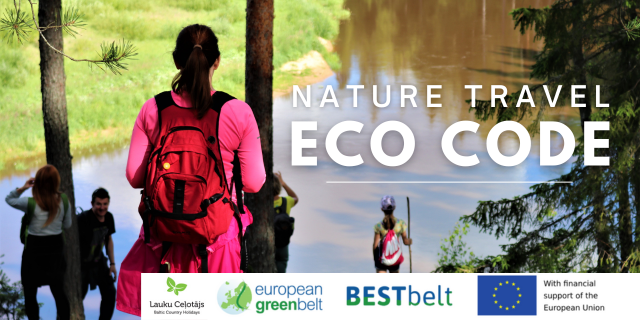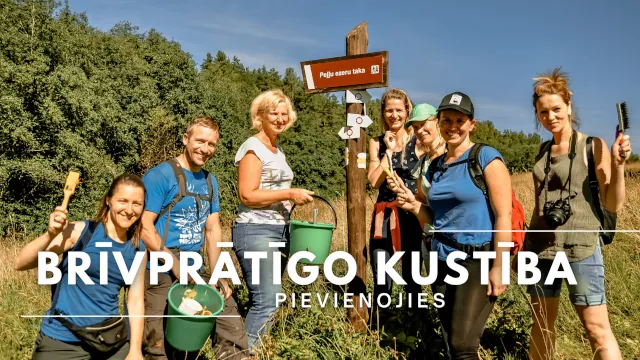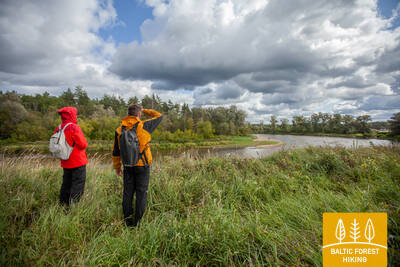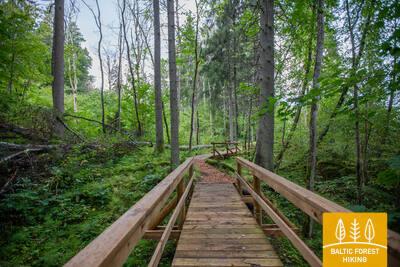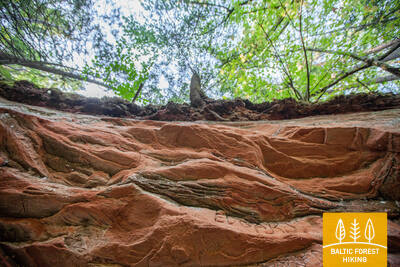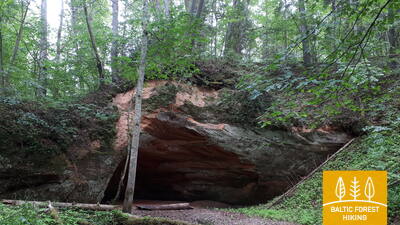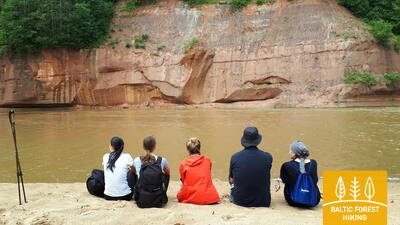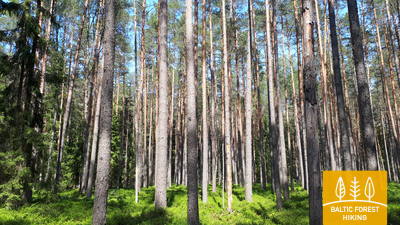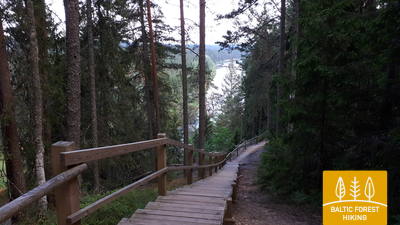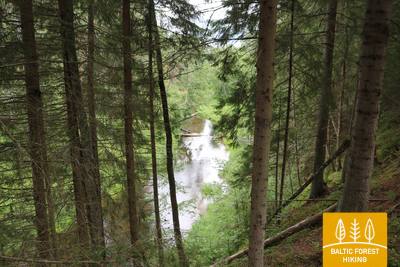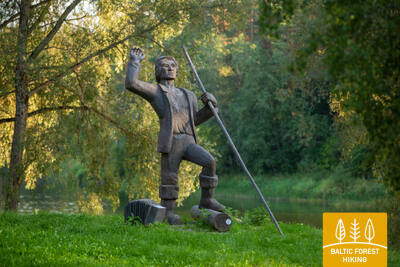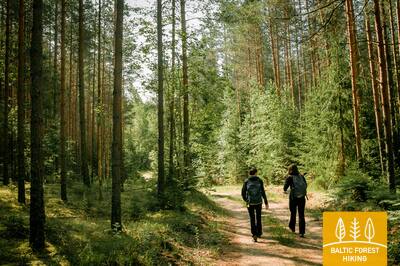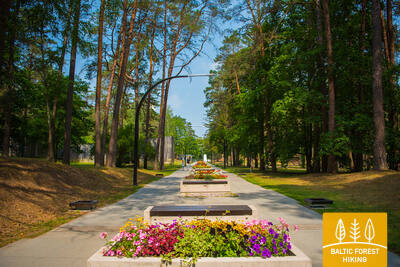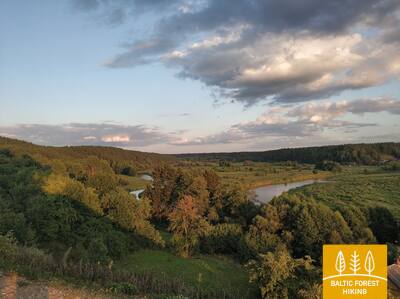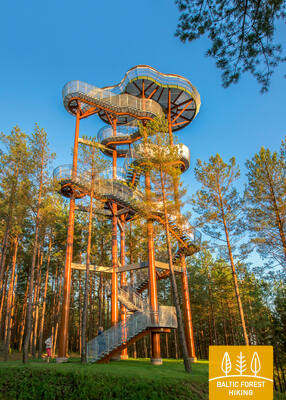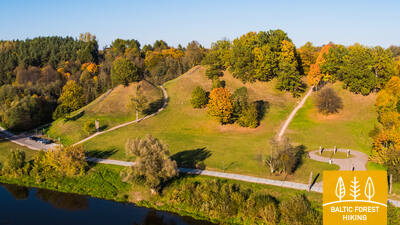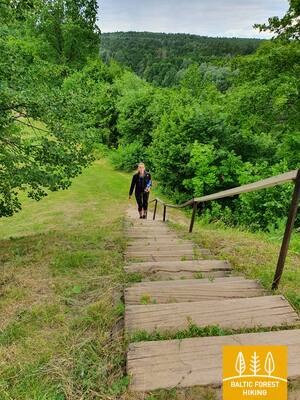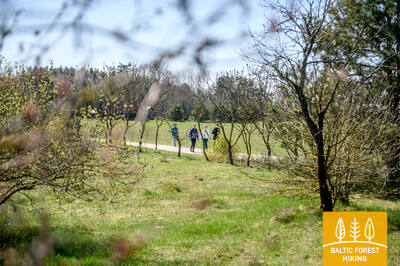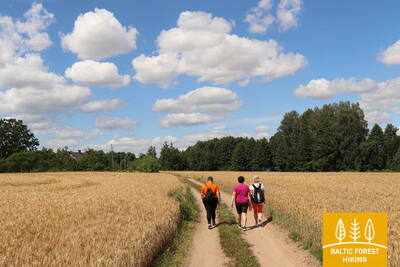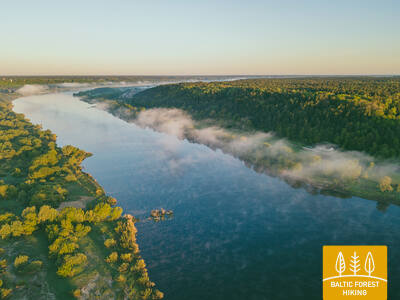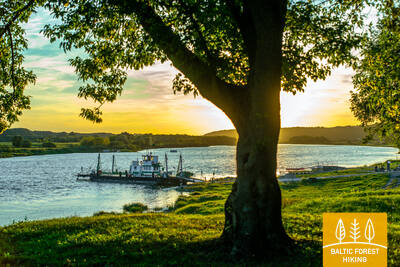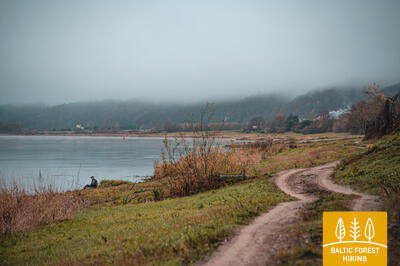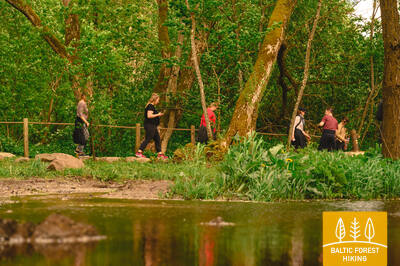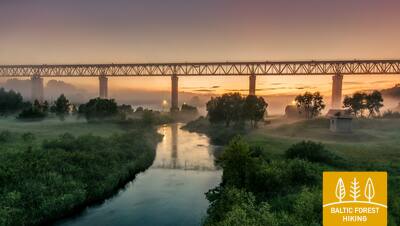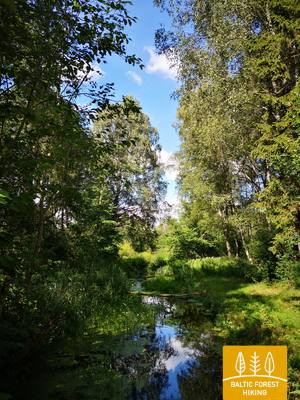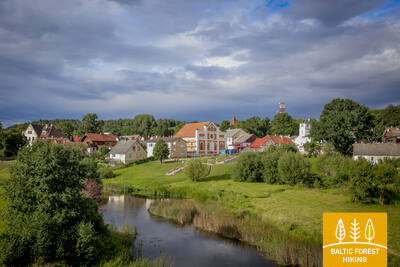Baltic Forest Hiking - Canoeing
 Section 1. Old Riga - Baltezers.
Section 1. Old Riga - Baltezers.
Through Riga – UNESCO World Heritage Site
The starting point of Forest Trail in Latvia is located in the heart of Old Riga, the Town Hall Square. The route leads along Kaļķu Street, passes the Monument of Freedom, through Vērmane Garden and along the historic Tērbatas street. Then it arches over the Zemitāni railway station pedestrian bridge and treads into Biķernieki and Šmerlis forests. The Forest Trail winds through Jugla, passes the Latvian Ethnographic Open-Air Museum and goes on along the pedestrian-bicycle path until Baltezers.
 Section 2. Baltezers - Vangaži.
Section 2. Baltezers - Vangaži.
The historic Tērbata road along the banks of Gauja River and lakes
The Forest Trail crosses the VIA Baltica motorway via a tunnel and goes on through a private housing along the Lake Mazais Baltezers. Then it turns east, following the Gauja-Baltezers Canal. In the Garkalne–Āņi section, beautiful meadows stretch on both sides of the Forest Trail, drowning in heaps of blossoming red catchflies, white daisies and yellow buttercups during the summer. Since days of old, medieval roads have ran along the banks of Gauja River, and travellers used the ferry crossing at Iļķene to get across. Beyond Āņi, the Forest Trail passes through forested areas and a populated country area, and finally reaches Vangaži via Gaujas street.
From Gaujiena to Garkalne, the Mežtaka trail runs close to the river, or in some places, along its (ancient valley) banks. This section can be used for canoeing or kayaking (approximately a week-long trip). The most popular section for water tourism on the Gauja is within Gauja National Park, between Valmiera and Sigulda or Rāmkalni (a trip lasting 3-5 days). For more information, see https://riverways.eu/en/
 Section 3. Vangaži - Rāmkalni.
Section 3. Vangaži - Rāmkalni.
Along Inčukalns hunting palace towards Gauja National Park
After leaving Vangaži, the Forest Trail leads through smaller paths, reaching Vangaži Lutheran Church and the Werewolf Pine. On its way to the Hunting Palace, it goes along the so-called Katrīna Road, disappears into the forest for a while and after the Hunting Castle continues along the Hunting trail. The first side ravines with pronounced relief of the ancient Gauja valley can be seen here. One of them is located by Inčukalns Velnala (Devil’s) Cave, surrounded by small river channels of old Gauja. From there, the Forest Trail continues through meadows and crosses the Murjāņi–Valmiera motorway, where the recreation park “Rāmkalni” is located.
From Gaujiena to Garkalne, the Mežtaka trail runs close to the river, or in some places, along its (ancient valley) banks. This section can be used for canoeing or kayaking (approximately a week-long trip). The most popular Gauja water tourism section is within Gauja National Park, between Valmiera and Sigulda or Rāmkalni (a 3-5 day trip). For more information, see https://riverways.eu/en/
 Section 4. Rāmkalni - Sigulda.
Section 4. Rāmkalni - Sigulda.
Stunning scenery of the ancient valley of Gauja River near Sigulda
Past “Rāmkalni”, the Forest Trail wanders up the steep banks of Gauja valley, passes through Gauja village and comes back down. Then it crosses river Lorupe and continues along the bends of river Gauja, passing one of the most spectacular outcrops of the river, the Velnala Cliffs, goes up to Ķeizarskats observation spot and circles down to Ķeizarkrēsls, adventure park “Mežakaķis” at Kaķīškalns and the Sigulda Bobsleigh and Luge Track.
From Gaujiena to Garkalne, the Mežtaka trail runs close to the river or, in some places, along its (ancient valley) banks. This section can be used for canoeing or kayaking (approximately a week-long trip). The most popular Gauja water tourism section is within Gauja National Park, between Valmiera and Sigulda or Rāmkalni (a 3-5 day trip). For more information, see https://riverways.eu/en/
 Section 5. Sigulda - Līgatne.
Section 5. Sigulda - Līgatne.
In the heart of Gauja National Park
After passing through Sigulda, the Forest Trail follows the River Vējupīte to Mound Paradīzes, where a steep staircase leads down into the ancient valley of Gauja River and the ravine of River Vējupīte. It continues to wind down smaller paths through meadows, crossing small rivers whose banks reveal sandstone outcrops. The last six kilometres of this section follow a smaller path down Līgatne Nature Trails. As it draws closer to Līgatne, the Forest Trail moves up the hills of Gauja valley, before descending back down into the deep ravine of Līgatne River, where the village of the former Līgatne Paper Mill is located.
From Gaujiena to Garkalne, the Mežtaka trail runs close to the river, or in some places, along its (ancient valley) banks. This section can be used for canoeing or kayaking (approximately a week-long trip). The most popular water tourism section on the Gauja is within Gauja National Park, between Valmiera and Sigulda or Rāmkalni (a 3-5 day trip). For more information, see https://riverways.eu/en/
 Section 6. Līgatne - Cēsis.
Section 6. Līgatne - Cēsis.
Along the old Cēsis road through the valley of Amata River
One of the most scenic parts of the Forest Trail stretches along the historic village of the Līgatne Paper Mill, passes Spriņģi Rock, curves along Skaļupe Trails and the Mythological Trail, stops at one of the most secret sites on this side of the Iron Curtain, the Soviet Bunker, then continues along Roči Nature Reserve, crosses Amata (the most beautiful and rockiest part of the river) and finally comes to Zvārtes Rock. Next, the Forest Trail runs along the high banks of Amata valley and follows the historic Cēsis–Riga “highway” (now a small rural/forest road with old mileposts) to Rakši, then ascends up the Vāļukalni hills and Ozolkalns, following along the River Gauja until it meets Cīrulīši Nature Trails. It comes to a stop at Gaujas street, but travellers may continue down the path for a further 2.8 km to Cēsis, spend the night there, and continue walking on the following day.
The section from Gaujiena to Garkalne on the Mežtaka trail runs close to the river or along its (valley) banks in some places. This section can be used for canoeing or kayaking (approximately a week-long trip). The most popular Gauja river tourism route is within the Gauja National Park, between Valmiera and Sigulda or Rāmkalni (a 3 to 5-day trip). For more information, see https://riverways.eu/en/
 Section 7. Cēsis - Caunītes.
Section 7. Cēsis - Caunītes.
Impressive sandstone outcrops on the banks of River Gauja
The Forest Trail follows small roads and trails through the woods up until the water tourist camp “Lenči”, winds through the ever-changing terrain past Ērģeļu Cliffs and enters the ancient valley of Gauja River. Having passed Ērģeļu Cliffs, the trail turns back towards Cēsis, but then veers off towards Rāmnieki in Pieškalns, crossing the river. After the water tourist camp “Jāņarāmis” the Forest Trail enters a beautiful, bright pine forest, proceeding through the woods until it reaches “Caunītes”, which is one of the most beautiful places on the banks of the Gauja River.
From Gaujiena to Garkalne, the Mežtaka trail runs close to the river, or in some places, along its (valley) bank. This section can be used for canoeing or kayaking (approximately a week-long trip). The most popular Gauja water tourism section is within the Gauja National Park, between Valmiera and Sigulda or Rāmkalni (a 3 to 5-day trip). For more information, see https://riverways.eu/en/
 Section 8. Caunītes - Valmiera.
Section 8. Caunītes - Valmiera.
On the road to Valmiera – the “Green City”
From Caunītes, the Forest Trail leads through mesmerising pine forests and wetlands, across and around hills and slopes. One of the most beautiful views of the River Gauja opens from Sietiņiezis, and it might be worth devoting some extra time to visit the Sietiņiezis Nature Trail. The further road stretches along farmsteads and through forests, until reaching Valmiera. After Valmiera bypass, the Forest Trail leads down urban sidewalks, while the last stretch of road – from the so-called “Dzelzītis” (a narrow-gauge railway bridge) to Cēsu street – follows a wooded path along the Gauja River.
From Gaujiena to Garkalne, the Mežtaka trail runs close to the river, or in some places along its (ancient valley) bank. This section can be used for canoeing or kayaking (approximately a week-long trip). The most popular Gauja water tourism route is within the Gauja National Park, between Valmiera and Sigulda or Rāmkalni (a 3 to 5-day trip). For more information, see https://riverways.eu/en/
 Section 9. Valmiera - Strenči.
Section 9. Valmiera - Strenči.
Along Abuls to Strenči, the capital of rafters
The trail passes through the historical centre of Valmiera and the Atpūtas Park, which is a popular place among hikers and Nordic walkers, then crosses the suspension bridge, passes Pauku priedes pine forest and Baiļu kalns. From there it follows the Abuls Trail, curving along the banks of the river until reaching the Brenguļi Brewery, and further down, beyond Pūpoli, enters vast, unpopulated forest areas. The first part of this section passes by numerous small summer cottage villages with names such as Enerģētiķis, Saulītes, Sprīdītis, Gaujmaļi, Pūpoli and Gaujaslāči, which were initially established during the Soviet period as summer cottage neighbourhoods of the people of Valmiera and the surrounding territories. Near Ūdriņas, the Forest Trail leads through a labyrinth of the riverbeds and turns north, crossing the Gauja Bridge, where a resting and boating stop is located. The centre of Strenči is located at a 1.5 km distance. Part of the section passes through the Northern Gauja protected landscape area.
The forest hiking trail from Gaujiena to Garkalne runs close to the river or, in some places, along its (ancient valley) bank. This section can be used for canoeing or kayaking (approximately a week-long trip). The most popular Gauja water tourism route is within the Gauja National Park, between Valmiera and Sigulda or Rāmkalni (a 3 to 5-day trip). For more information, see https://riverways.eu/en/
 Section 10. Strenči - Spicu Bridge.
Section 10. Strenči - Spicu Bridge.
Through the beautiful forests of Vidzeme
The beginning of the Forest Trail at this section coincides with the Gauja Nature Trail, which runs along the very bank of the river. The Forest Trail crosses the A3 in two places (before the turn to Seda and before Kauči) (be careful!) and continues along small forest roads, a sand-gravel quarry, then continues down a gravel road at the turn to Oliņas. After 3.5 km, turn right again and follow the route to Spicu Bridge via small and remote forest roads where some of the most beautiful sights of the Northern Gauja (“Ziemeļgauja”) protected landscape area can be seen by the so called Zemā sala (Low Isle). A picnic area and a camp are located at the end of this section, where the P24 crosses the Spicu Bridge.
The Mežtaka trail from Gaujiena to Garkalne runs close to the river or, in some places, along its (ancient valley) bank. This section can be used for canoeing or kayaking (approximately a week-long trip). The most popular Gauja water tourism route is within the Gauja National Park, between Valmiera and Sigulda or Rāmkalni (a 3 to 5-day trip). For more information, see https://riverways.eu/en/
 Section 11. Spicu Bridge - Zaķi.
Section 11. Spicu Bridge - Zaķi.
Through the magnificent Cirgaļi dunes
The Forest Trail crosses Spicu Bridge and leads to the four Kokši lakes (about 4 km), which are interconnected by a small stream. Here you will find a picnic area, tent spots and a nature trail for travellers. The surrounding nature is beautiful, and the forests are rich in edible mushrooms. After passing the last of the Kokši lakes, Lake Dibena, in an hour or two you will reach the Cirgaļi dune massif, which you will cross towards north-south. The further section of the Forest Trail crosses a large forested area, and a lone homestead or a smaller lake can be seen here and there. The section ends in a small village named Zaķi. The village provides no services, so be sure to consider the necessary arrangements and accommodation options as you plan your hike. The section is located in the Northern Gauja (“Ziemeļgauja”) protected landscape area.
The Mežtaka trail from Gaujiena to Garkalne runs close to the river, or in some places along its (ancient valley) bank. This section can be used for canoeing or kayaking (approximately a week-long trip). The most popular Gauja water tourism route is within the Gauja National Park, between Valmiera and Sigulda or Rāmkalni (a 3 to 5-day trip). For more information, see https://riverways.eu/en/
 Section 12. Zaķi - Gaujiena.
Section 12. Zaķi - Gaujiena.
Along Zvārtava Castle to Gaujiena
1.5 km after Zaķi the Forest Trail turns off the Sēļi–Vireši road (P23) and continues on a small rural road all the way to Zvārtava, where Zvārtava Castle awaits at the end of a long alley. Having passed through Zvārtava, the Forest Trail returns to P23 and after a 2 km walk goes up a steep hill, reaching the centre of Gaujiena. A part of the section is located in the Northern Gauja (“Ziemeļgauja”) protected landscape area.
The Mežtaka trail from Gaujiena to Garkalne runs close to the river, or in some places along its (ancient valley) bank. This section can be used for canoeing or kayaking (approximately a week-long trip). The most popular Gauja water tourism route is within the Gauja National Park, between Valmiera and Sigulda or Rāmkalni (a 3 to 5-day trip). For more information, see https://riverways.eu/en/
 Section 54. Didžiasalis – Druskininkai – Žiogeliai.
Section 54. Didžiasalis – Druskininkai – Žiogeliai.
Druskininkai – the most popular resort in Southern Lithuania
Between Didžiasalis village and the resort town of Druskininkai, the Forest Trail leads through a coniferous forest with abundant berry and mushroom spots. Before Druskininkai, the Forest Trail merges with the Nemunas road, turns around the Druskininkai Snow Arena and continues along the pedestrian and bicycle path to the Park Bridge across the Nemunas river. After crossing the bridge, the Forest Trail continues on Maironio street. and continues along the small streets of the historic Druskininkai resort and the park roads, crossing the Ratnyčia river and the forest park on the right bank of the Nemunas. The route behind Veisiejai street goes along the sidewalk of Neravų street and after about 1 km turns left into Sodžiaus street, which at the end of Neravai village becomes a beautiful forest road. This is where Dzūkija National Park begins. The Forest Trail turns around Viečiūnai village, opening a beautiful landscape to the Liškiava monastery on the opposite bank of the Nemunas. The Forest Trail then leads to Žiogeliai village along a beautiful secluded forest road.
From Druskininkai to Kaunas (Druskininkai - Merkinė - Alytus - Birštonas - Pakuonis - Piliuona - Kaunas) and beyond the Kaunas Reservoir, the Forest Trail more or less follows the Nemunas Valley. The Nemunas section from Druskininkai to Piliuona is navigable by canoe or kayak (Druskininkai - Piliuona along the Nemunas River - about 200 km, 7 - 10 days of paddling).
 Section 55. Žiogeliai – Merkinė.
Section 55. Žiogeliai – Merkinė.
Through the Dzūkija National Park
Up to the Merkys estuary to the Nemunas, the Forest Trail leads along the banks of the Nemunas valley, where it is surrounded by large and beautiful forests of Dzūkija in the vicinity of the Dainava Lowland (Dainavos lyguma). In some places in the forest massif there are open places where small villages are scattered. Nearby Česukai village, the Forest Trail forms a large circle around the Merkys estuary to the Nemunas, because the nearest bridge is on the A4 road. Here you can see picturesque landscapes over the wide and deep Merkys valley. After crossing Merkys, the Forest Trail stretches along a narrow country road on the left bank of the river and leads to the Merkinė mound, from which one of the most beautiful landscapes of Southern Lithuania opens up. Along the small and winding streets of Merkinė (Piliakalnio, V. Sladkevičiaus, S. Dariaus and S. Girėno) the Forest Trail reaches the town centre. This section of the Forest Trail is a part of Dzūkija National Park.
From Druskininkai to Kaunas (Druskininkai - Merkinė - Alytus - Birštonas - Pakuonis - Piliuona - Kaunas) and beyond the Kaunas Reservoir, the Forest Trail more or less follows the Nemunas Valley. The Nemunas section from Druskininkai to Piliuona is navigable by canoe or kayak (Druskininkai - Piliuona along the Nemunas River - about 200 km, 7 - 10 days of paddling).
 Section 56. Merkinė – Nemunaitis.
Section 56. Merkinė – Nemunaitis.
Along the Nemunas valley
In Merkinė small town, the Forest Trail goes along Seinų street in the direction of the Nemunas, turns right and comes to the observation tower. It offers an excellent landscape over the wide river valley and the island in the Nemunas river, which is grazed by livestock. For more than 3 km, the Forest Trail moves to the steep slopes of the Nemunas valley, then sharply turns to the north and further goes along small forest roads to the villages of Netiesos and Druskininkai. After Druskininkai village, it crosses the largest open area of this section with beautiful views. Then the Forest Trail runs along the Nemunas valley, but the river itself is not visible from the trail. In some places along the way there are hills with steep slopes. At Vangelonys village, the Forest Trail comes out again in an open place, crosses a small forest massif and reaches the main street of Nemunaitis village along Vangelonių and Saulėtekio streets. Part of this section from Merkinė to Druskininkai village is located in Dzūkija National Park.
From Druskininkai to Kaunas (Druskininkai - Merkinė - Alytus - Birštonas - Pakuonis - Piliuona - Kaunas) and beyond the Kaunas Reservoir, the Mežtaka Trail more or less follows the Nemunas Valley. The Nemunas section from Druskininkai to Piliuona is navigable by canoe or kayak (Druskininkai - Piliuona along the Nemunas River - about 200 km, 7 - 10 days of paddling).
 Section 57. Nemunaitis – Alytus.
Section 57. Nemunaitis – Alytus.
Across the highest pedestrian bridge to Alytus
From Nemunaitis along Vytauto street and the Kaniūkai–Einorai–Nemunaitis road (no. 1102), the Forest Trail goes 1.5 km in northeast direction, then turns left to the north and after 3 km reaches Gečialaukis village. Then the Forest Trail turns right to the east and after 3.3 km meets the road No. 1102 again. After another 3.3 km, the Forest Trail reaches road No.128 and descends along the sidewalk in the Nemunas valley. From here, a beautiful trail in the Nemunas valley with a length of more than 3 km leads through the forest to a pedestrian bridge across the river. After a long ascent to the highest pedestrian bridge in Lithuania, there opens a view of the endless and mighty landscape of the Nemunas. After the bridge, the Forest Trail passes along the former railway dam, meanders along the streets of the Alytus resort park, and in the centre of the town, along S. Dariaus and S. Girėno street goes to the Old Town Square. The Alytus Tourism Information Center is located on its southern side.
From Druskininkai to Kaunas (Druskininkai - Merkinė - Alytus - Birštonas - Pakuonis - Piliuona - Kaunas) and beyond the Kaunas Reservoir, the Mežtaka Trail more or less follows the Nemunas Valley. The Nemunas section from Druskininkai to Piliuona is navigable by canoe or kayak (Druskininkai - Piliuona along the Nemunas River - about 200 km, 7 - 10 days of paddling).
 Section 58. Alytus – Panemunis.
Section 58. Alytus – Panemunis.
Along the hills of the Dzūkija Upland
From Alytus, the Forest Trail takes you along Vilniaus street, crosses the Nemunas through the A. Juozapavičiaus Bridge, then turns left to the north along Jiezno street and further crosses the Normandy–Nemunas road along Miškininkų street (No. 1334). Having passed almost 2 km through the forest, the Forest Trail comes out on a small country road and goes another 8 km in a northern direction. There are vast and open landscapes of the Dzūkija Upland in this area. After Staniava village the Forest Trail leads down a beautiful forest road to the Nemunas and then up a steep slope to the Punia castle mound, which overlooks the river. Along the Punia church along Kauno, Šilo and Birštono streets, after less than 4 km, the Forest Trail reaches a larger forest massif. Crossing it, after 5 km the Forest Trail comes out to Nemajūnai village. 3.5 km away is the destination of this section.
From Druskininkai to Kaunas (Druskininkai - Merkinė - Alytus - Birštonas - Pakuonis - Piliuona - Kaunas) and beyond the Kaunas Reservoir, the Forest Trail more or less follows the Nemunas Valley. The Nemunas section from Druskininkai to Piliuona is navigable by canoe or kayak (Druskininkai - Piliuona along the Nemunas River - about 200 km, 7 - 10 days of paddling).
 Section 59. Panemunis – Birštonas.
Section 59. Panemunis – Birštonas.
Nemunas loops and ethnographic farmsteads
Repeating the loops of the Nemunas, the Forest Trail throws more than 20 km long bends in Nemunas Loops Regional Park, winding through open landscapes and small villages with typical wooden buildings painted in different shades. A larger forest massif there is only between Siponiai and Puzoniai villages, through which the route leads along small forest roads. Crossing the Vilnius–Marijampolė road (A16), the Forest Trail descends to the next circle of the Nemunas, where the popular Birštonas resort is located. Along the sidewalk of B. Sruogos street, the Forest Trail reaches the Birštonas Tourism Information Center.
From Druskininkai to Kaunas (Druskininkai - Merkinė - Alytus - Birštonas - Pakuonis - Piliuona - Kaunas) and beyond the Kaunas Reservoir - to Seredžius, the Forest Trail more or less follows the Nemunas Valley. The Nemunas section from Druskininkai to Piliuona is navigable by canoe or kayak (Druskininkai - Piliuona along the Nemunas River - about 200 km, a 7 - 10 day paddling trip).
 Section 60. Birštonas – Alksniakiemis.
Section 60. Birštonas – Alksniakiemis.
Through the Birštonas resort
After the Birštonas Tourist Information Centre, the Forest Trail leads for more than 1 km along the Nemunas bank promenade, then turns onto Algirdo street, crosses Vytautas Jurgis Meška Park, returns to the promenade and after 0.6 km turns onto the pedestrian and bicycle path. The path crosses the Žvėrinčiaus forest for about 5 km, and then the leads through the Paprienė recreation area, reaching the Greimų bridge over the Nemunas river. Behind the bridge the Forest Trail moves along the Vytauto, Nemuno, J. Zdebskio, Kęstučio, J. Basanavičiaus streets and along Kęstučio street (No. 3306) exits from the central part of Prienai. Along Paupio street, it forms a loop around the Nemunas and about 7 km from the centre of Prienai turns left to northeast towards Alksniakiemis. Part of this section is located in Nemunas Loops Regional Park.
From Druskininkai to Kaunas (Druskininkai - Merkinė - Alytus - Birštonas - Pakuonis - Piliuona - Kaunas) and further beyond the Kaunas Reservoir - up to Seredžius, the Forest Trail more or less follows the Nemunas Valley. The Nemunas section from Druskininkai to Piliuona is navigable by canoe or kayak (Druskininkai - Piliuona along the Nemunas River - about 200 km, 7 - 10 days of paddling).
 Section 61. Alksniakiemis – Pakuonis.
Section 61. Alksniakiemis – Pakuonis.
Along the banks of the Nemunas through the Kalviai forest
From Alksniakiemis, the Forest Trail winds along a small country road on the left bank of the Nemunas and forms a more than 7 km long loop of forest roads and trails through the Kalviai Forest Massif (Kalvių Miškas). From Vangai village to Pašventupys, about 3 km, the Forest Trail winds along the banks of the Nemunas, from which picturesque panoramas open. Hikers will be delighted by the ever-changing landscape: small villages with gardens and fields sinking in the flowers in spring and summer, as well as fishing boats or other little boats on the flat river bank. From Pašventupys village the Forest Trail by road No. 3313 after about 3 km reaches the centre of Pakuonis town.
From Druskininkai to Kaunas (Druskininkai - Merkinė - Alytus - Birštonas - Pakuonis - Piliuona - Kaunas) and further beyond the Kaunas Reservoir - up to Seredžius, the Forest Trail more or less follows the Nemunas Valley. The Nemunas section from Druskininkai to Piliuona is navigable by canoe or kayak (Druskininkai - Piliuona along the Nemunas River - about 200 km, 7 - 10 days of paddling).
 Section 63. Vaišvydava – Kaunas.
Section 63. Vaišvydava – Kaunas.
Through Kaunas parks
From the Kaunas Lagoon Regional Park Visitor Centre, the Forest Trail leads through the Rokų forest and along the Miškininkų, Kelmyno, Muraškinės, Žarstos, Garšvės and Rokelių streets, circles the Kaunas suburbs, crosses the Marijampolė road (No. 139) and continues in the direction of Balčkalnio street to Panemunė district. At the stadium of Kaunas University of Technology Engineering Lyceum, it descends to Vaidoto street, then continues along the sidewalk to Baterijos highway, where it turns left. About a third of Kaunas city area is occupied by parks and other nature territories. The Forest Trail crosses the city through its greenest parts. About 2.5 km long the Forest Trail passes through the Panemunė pinewood, which has a dense network of trails, recreation areas and a beach. The Forest Trail crosses the Nemunas along the Three Virgin Bridge, leads through Gričiupis district, runs along Kaunas Zoo, crosses the vast Oak-Wood Park (Ąžuolynas) and leads through Vytauto Park behind the Lithuanian Sports University. Down the park stairs, the path descends to the beginning of the Avenue of Freedom (Laisvės Alėja) and continues to the destination of the section in Kaunas center.
IMPORTANT. There are no markings where itineraries are crossing the territory of Kaunas city.
 Section 64. Kaunas – Lampėdžiai.
Section 64. Kaunas – Lampėdžiai.
Through the historical centre of Kaunas
Kaunas is the second largest city in Lithuania. The 1621 m long Avenue of Freedom (Laisvės Alėja) stands out for its unique modernist architecture – its 1914–1940 buildings has received the European Heritage Label. Vilniaus street is the “gateway” to the medieval city of Kaunas, run by Hanseatic merchants. The Forest Trail runs along Avenue of Freedom (Laisvės Alėja), crosses the Old Town of Kaunas with churches, the Town Hall Square and historical buildings, and throws a circle along Confluence Park (Santakos parkas), where Lithuania's largest rivers, the Nemunas and the Neris, meet. After crossing the Neris river, the Forest Trail continues along the footpaths and bicycle paths to the 4 km distant former Lampėdis gravel quarry, which is flooded and now is a popular place for recreation and swimming.
IMPORTANT. There are no markings where itineraries are crossing the territory of Kaunas city.
 Section 65. Lampėdžiai – Kulautuva.
Section 65. Lampėdžiai – Kulautuva.
Along the bank of the Nemunas
The first 2 km the Forest Trail winds along the northern shore of the Lampėdis quarry and leads to the highway in front of the cemetery. Continuing its journey along the sidewalk in the direction of Raudondvaris, the Forest Trail crosses the Nevėžis river. After 0.6 km, the Forest Trail turns left onto Pakalnės street and, in front of the confluence of the Nevėžis and Nemunas, continues along small paths on the right bank of the Nemunas. Old mounds can be seen on the banks of the Nemunas valley. Beyond Šilelis village, the Forest Trail continues along a pedestrian / bicycle path to the small-town of Kulautuva, in front of which it throws a circle along a small forest path. Then the trail moves along Pušyno and V. Augustausko street until it reaches the destination of this section.
IMPORTANT. There are no markings where itineraries are crossing the territory of Kaunas city.
 Section 66. Kulautuva – Vilkija.
Section 66. Kulautuva – Vilkija.
Along the meadows of the floodplains of Nemuna
Throughout this section, the Forest Trail leads along paths and small country gravel roads on the right bank of the Nemunas. Beautiful landscapes with views of the river, riverside meadows and small villages. The destination of the section – the Vilkija ferry can be seen from afar on the banks of the Nemunas. Opposite the ferry there is a centre of the small-town with a church. In the second half of the summer, the Nemunas meadows bloom in yellow and blue flowers. It is worth trying a round-trip ferry, because such a vehicle is preserved in only a few places in the Baltic States.
 Section 67. Vilkija – Padubysys.
Section 67. Vilkija – Padubysys.
Between the valleys of two rivers – the Nemunas and the Dubysa
The first kilometre the Forest Trail leads along the very bank of the Nemunas, then turns off the Kaunas–Jurbarkas road (No. 141) and continues on a pedestrian / bicycle path to Ringovė mound. Turning to the right to the north, the Forest Trail crosses a small forest massif (entomological nature reserve for insect protection) and further follows the road No. 1929. After 2 km, the Forest Trail turns left and travels through agricultural lands. Before Lazduoniai village, it crosses the deep valley of the Lazduona river, follows the road No. 1917 for 0.2 km and then turns right to the northwest until it reaches the deep and wide Dubysa river valley. In the next 2 km, the Forest Trail winds along a country road on the left bank of the Dubysa, where you can see rare farmsteads. The river water is clear in summer, the flow is calm and it is interrupted only by the remnants of the former mill dam. Finally, the Forest Trail winds up on the steep bank of the Dubysa river valley and reaches the destination of this section.
 Section 68. Padubysys – Ariogala – Kirkšnovė.
Section 68. Padubysys – Ariogala – Kirkšnovė.
On the way to one of the oldest settlements in Lithuania – Ariogala
Winding on the steep bank of the Dubysa valley, the Forest Trail crosses a small forest for 2.5 km and further 4 km up to Čekiškė through an area where large corn fields bloom in summer. A similar landscape can be seen for the next 9 km, until the Forest Trail crosses the Kaunas–Klaipėda highway (A1) along the bridge. About 1.5 km further, before Gėluva village, the Forest Trail descends into the deep Dubysa valley and winds along small paths and quiet country roads along the bends of the river, revealing wide views of the town of Ariogala at the top of the valley. Along Dubysos and Gedimino streets, it winds up to the town's central street, Vytauto street. Further along Plento street, the Forest Trail 5 km from the centre reaches the point where you have to turn to the end of the section – Krikšnovė pond (another 0.2 km).
 Section 69. Kirkšnovė – Kaulakiai.
Section 69. Kirkšnovė – Kaulakiai.
Through Dubysa Regional Park
About 0.5 km after Kirkšnovė the Forest Trail turns left from the Ariogala–Betygala road (No. 3504) and then up to the destination at the Raseiniai–Baisogala road (No. 225) winds along the bends of the Dubysa river, where floodplain meadows alternate with small forest massifs and little villages. In some places there are vast views of the high banks of the Dubysa valley and the castle mounds. There is a pronounced land relief in this section – the Forest Trail winds up and down the steep slopes of the shores, ensuring a memorable hiking experience. This is a section for hikers – “gourmets”!
 Section 70. Kaulakiai – Šiluva.
Section 70. Kaulakiai – Šiluva.
Dubysa valley and the highest railway bridge in Lithuania
Moving along the Raseiniai–Baisogala road (No. 225) and along its pedestrian sidewalk, the Forest Trail crosses the deep Dubysa valley and turns right at the village of Ginčaičiai. After throwing a wide circle through the surrounding countryside, after 6 km it leads to the Raseiniai–Šiluva road (No. 148) and after about 3 km, crossing the Dubysa valley again, it reaches the Kušeliškė village. For the next 5.5 km, the Forest Trail runs along the Kušeliškė–Lyduvėnai (No. 3516) road, where the famous and scenic Lyduvėnai railway bridge can be seen in the distance. On the bend of the road before the Dubysa motorway bridge, the Forest Trail turns right to the northeast and along the road No. 3544 after 9 km reaches Šiluva, but after another 0.8 km – the centre of the town. At this section, the terrain of the neighbourhood is gradually becoming more pronounced, as it leads to the area where the Dubysa valley alternates with the southern part of the East Žemaitija Upland. The section of the route to Lyduvėnai leads along or nearby the Dubysa Regional Park, but Šiluva is part of the next section – Tytuvėnai Regional Park.
 Section 72. Aukštiškiai – Dengtiltis.
Section 72. Aukštiškiai – Dengtiltis.
Through the picturesque Šimša Forest
The section of the route leads to the East Žemaitija Upland (also known as East Samogitian Upland). The Forest Trail bends through for 5 km between cultivated fields, crosses the Šiauliai – Tauragė railway line and reaches Kiaunoriai village through small forest roads in Šimša Forest in Tytuvėnai Regional Park. It leads through the village along the main street – Draugystės street, and after 0.5 km turns left to the northwest (road No. 2122); after 4 km it reaches Pašiaušė village. After another 4 km, the Forest Trail descends into the Dubysa valley and turns left, where it meanders along the right bank of the river. After 0.5 km, the route reaches the final destination of the section. Dengtiltis and the next section of the Forest Trail are located in Kurtuvėnai Regional Park.
 Section 94. Renda – Sabile.
Section 94. Renda – Sabile.
To the town of wine and cider – Sabile
The Forest Trail in Renda for a short distance circles along the rocky banks of the Īvande river and then leads to Kroju Road. At first you can see open landscapes, but later the trail continues through the forest. In some places there are views of the Abava valley. The natural landscapes are gradually changing, as the Forest Trail leaves the Pieventa plain of the Kursa Lowland and slowly rises to the Vāne descent of the Austrumkursa Upland, reaching 50–60 m above sea level. Before Valgale village, it turns around the deep ravine of the Valgale river and goes to Sabile along the upper bank of the Abava valley, and only nearby Sabile descends to Abava bridge (Lāčplēša, Kuldīgas street). In the vicinity of Sabile, the natural areas are changing again and the landscapes of the Saldus hills of the Austrumkursa Upland can be seen here. The depth of the Abava valley between Rumbciems and Sabile reaches about 40 m. The Forest Trail today and the next day crosses the nature park “Abavas senleja” (“Abava valley”).
The section of the Abava River from Kandava to Renda is popular for canoeing, kayaking, and other boating activities. For more information, see https://riverways.eu/en/
 Section 95. Sabile – Kandava.
Section 95. Sabile – Kandava.
One of the most beautiful nature parks in Kurzeme
The Forest Trail continues along the left bank of the Abava, along Kr. Barona street. Further, as a small path, it crosses the meadows and forest clusters of the Abava valley until it reaches a hill called the Swedish hat (Zviedru cepure). After Zviedru cepure, the Forest Trail goes along a small country road to the Plosti – Pūces road (V1471), crosses Amula and at Kalnmuiža winds up in the Abava valley, along which the next 6 km leads to Aizdzire Manor park. Another 1 km to the north the Forest Trail crosses the Abava valley in its full width, revealing some of the most beautiful views of the valley. The depth of the Abava valley in this place is about 40 m. After the Fisherman's Bridge (Zvejnieku tilts), the Forest Trail rises on the northern slope of a valley where vineyards are planted. Winding through the forest, it crosses the Kandava–Renda road (P130) and further along Sabiles street reaches Kandava. Along the Lauku, Ozola, Zīļu, Sabiles and Pils streets of this picturesque small-town the Forest Trail reaches the Knights' Castle Mound. Throughout the section, the Forest Trail winds through the nature park “Abavas senleja” (“Abava valley”).
The section of the Abava River from Kandava to Renda is popular for canoeing, kayaking, and other boating activities. For more information, see https://riverways.eu/en/









